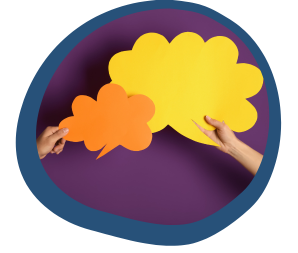Posted on Apr 28, 2024
Why Do Companies Invest In Facilitating Dialogue Rather Than Discussion Within Their Teams?
How do we help teams to facilitate the right conversation?

Have you ever heard expressions like "the quality of a business hinges on the quality of its communication," or "science is rooted in conversations," or even "in my team, the best ideas win"? Do we really know what these statements look like in their application?
What we've observed is that when misunderstanding and miscommunication arise within a team, there's a tendency to hold more meetings, engage in more conversations, and initiate more discussions. This often leads to what we call the "bigger hammer syndrome," where communication issues persist, and the solution seems to be more communication.
However, the truth is that the more we aim to achieve clarity through additional conversations and meetings, the more convoluted the situation becomes.
This is the moment to wonder: How can we have one powerful meeting to help us make progress toward our desired outcomes? In other words, you can ask yourself whether I should have a “discussion” with my team or a “dialogue.”
Peter Senge, In his work "The Fifth Discipline," draws a crucial distinction between dialogue and discussion. Based on his work and our own decade of experience, we aim to explore this difference and illustrate how you can consciously transform some of your “discussions” into “dialogues,” thereby ensuring effective and innovative decision-making.
Let's delve deeper into this topic, keeping it simple, straightforward, and practical.
What Is Dialogue?
The aim of the dialogue is not to come to a consensus but to broaden our understanding by tapping into collective intelligence and accessing a wealth of meaning beyond our individual reach.
In dialogue, individuals hold onto their assumptions but freely communicate them, unafraid of sharing. The goal is not to suppress or deny assumptions but to lay them on the table, examine them, identify inconsistencies, and understand how they influence our judgments. Participants in dialogue begin to observe their own thoughts and assumptions from an external standpoint, enabling them to evaluate and refine them further. Bohm identifies three essential conditions for dialogue:
- All participants must aim to become aware of their assumptions and be open to examining them.
- All participants must view each other as colleagues, prioritizing the benefits of dialogue over individual status or rank.
- A facilitator must guide the dialogue, ensuring that old communication habits do not resurface.
As a bonus point, dialogue is less reliant on existing chemistry and trust within the team; rather, it acts as a catalyst for building trust, which is essential for effective discussion.
These conditions foster a smooth flow of ideas, leading to the creation of a larger collective intelligence with minimal resistance and wasted energy.

What Is Discussion?
In contrast to dialogue, the purpose of discussion is often to reach a conclusion, akin to winning a debate or decision-making. Bohm notes that "discussion" shares roots with words like "percussion" and "concussion," implying a back-and-forth exchange resembling a ping-pong game, where participants aim to assert their viewpoints or reach a decision.Some notable conditions in discussions include:
- Participants come prepared to assert their viewpoints.
- There's a mindset geared towards evaluation and decision-making.
- The facilitator ensures that the meeting concludes with a single decision.
Discussions often rely heavily on pre-existing trust and chemistry within the team.
When To Use Dialogue And Discussion?
When confronted with a complex problem or unsure of where to begin, engaging in dialogue can provide a deeper understanding and richer insight into the issue. The goal isn't agreement but rather to access a broader understanding collectively. Even if disagreements arise, the focus remains on listening, understanding, and building upon each other's insights until a shared understanding emerges.
Once a deeper understanding is achieved, and there's a collective intelligence on the topic that surpasses individual perspectives, it may be appropriate to transition into a discussion to reach a decision and move forward.
About the Author: The human brain, behaviour, and interactions with their environment never fail to intrigue Samin Saadat. After spending long hours in psychology labs at UBC and completing her Master's at the Sauder School of Business, she entered the workforce. She observed a gap between what research suggests and what companies do to increase productivity and profitability. Over the last 10 years, Samin has developed expertise in people growth and culture building by working closely with business owners and individuals to develop the right mindset, skills and environment for cultivating a thriving workforce. Also, Samin strongly believes every single individual, regardless of their race, age, status, gender, position, mental health matters and physical conditions, deserves to reach their full potential. They all have something unique to offer. Now, Samin is on a mission to bridge the existing gap in the workforce and support individuals and companies to reach their full potential through Jalapeño Employee Engagement—leveraging technology and psychology to bring research findings to life to help companies save invaluable dollars and to help individuals enhance their quality of life.